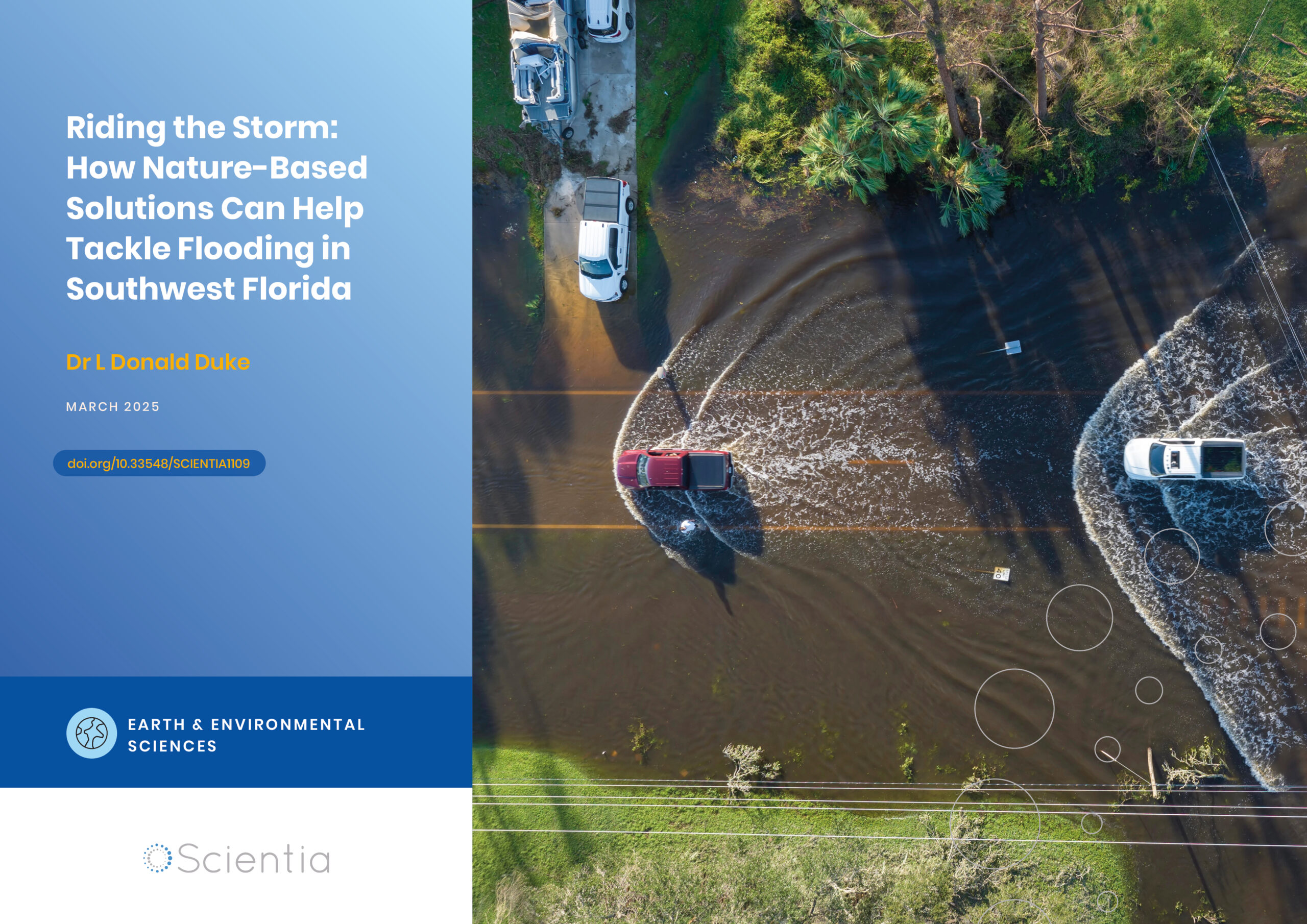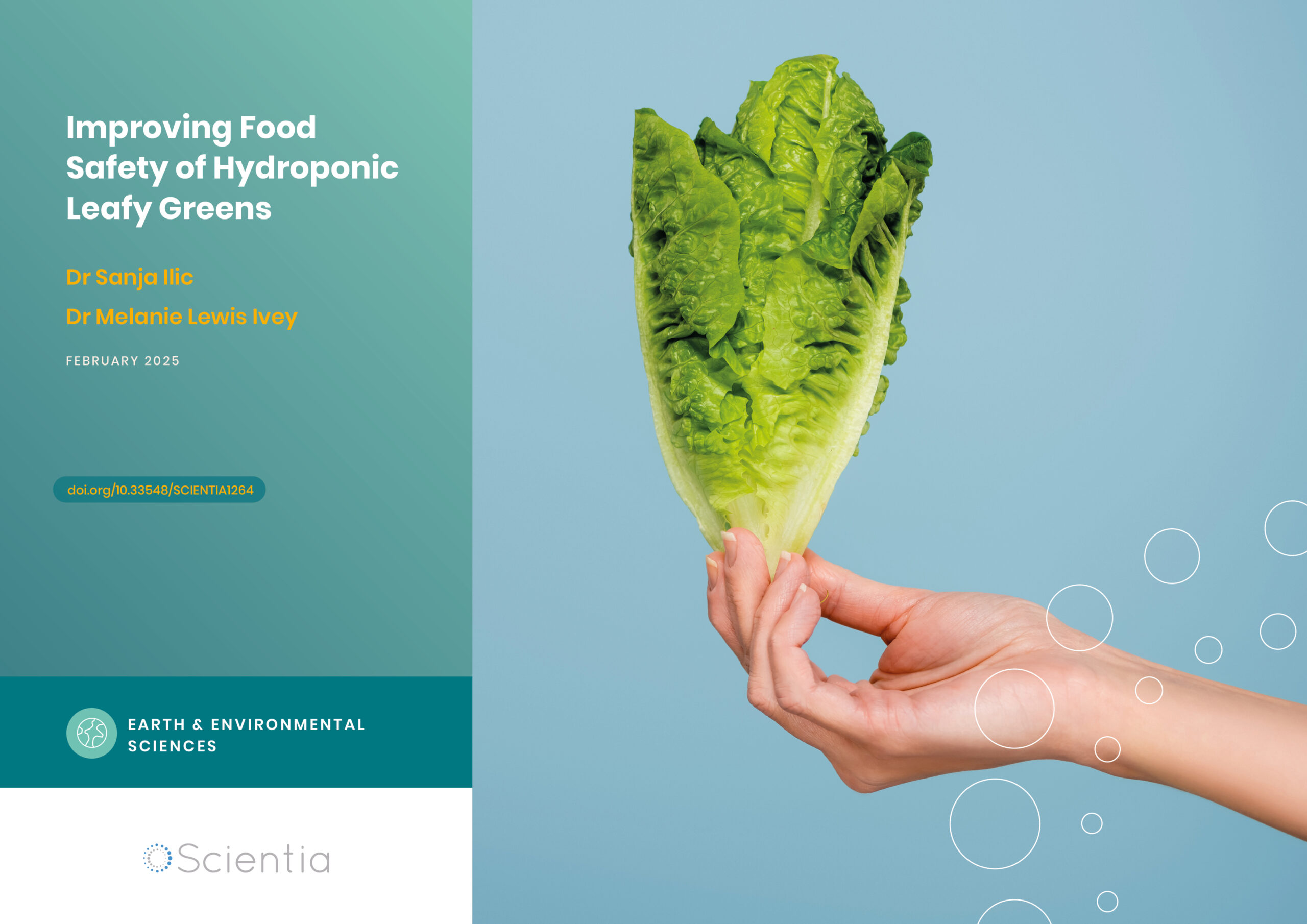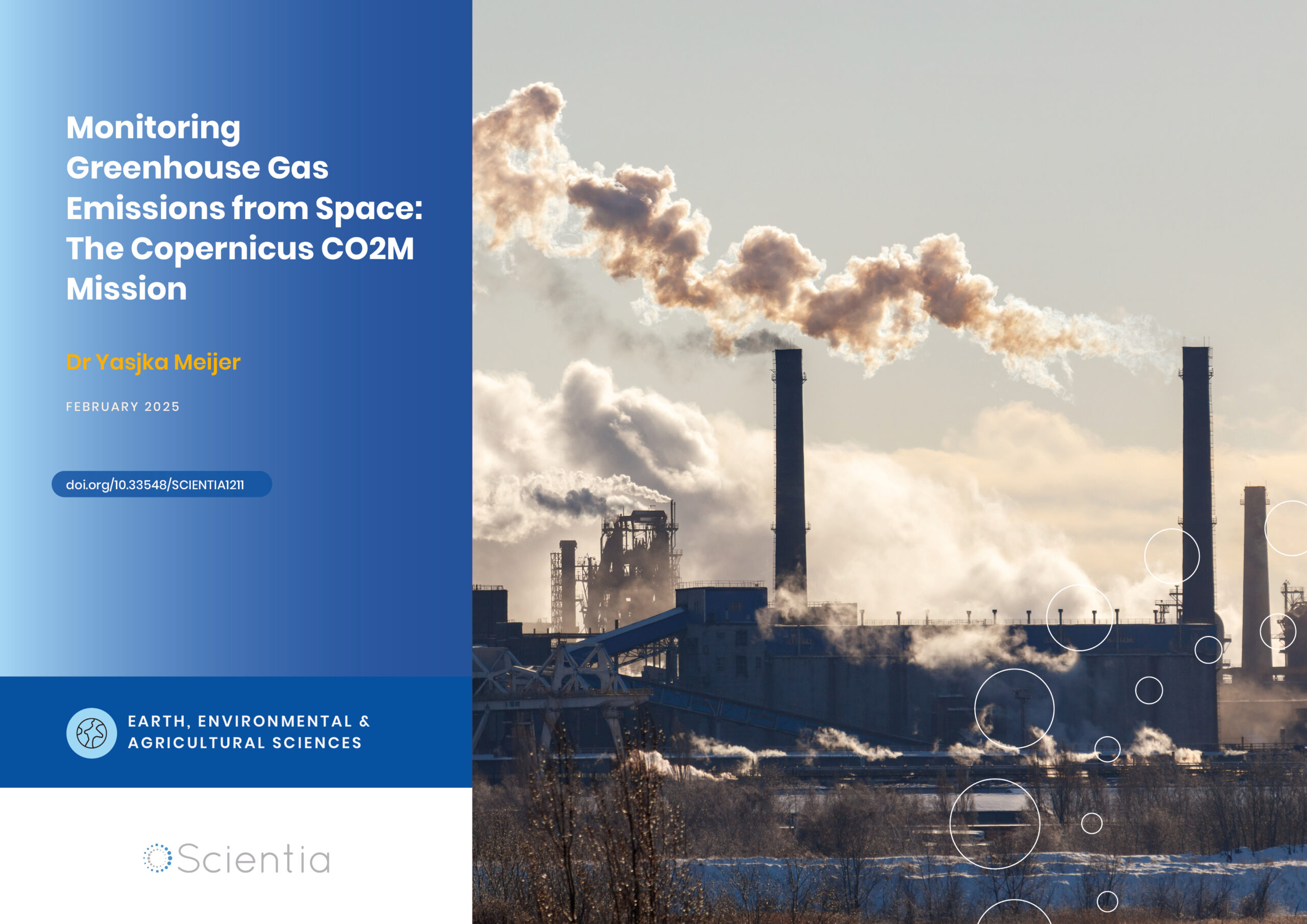Dr Arne Stensvand | Thermotherapy: Effective Disease and Pest Management Without Chemicals
Dr Arne Stensvand and his team at the Norwegian Institute of Bioeconomy Research are developing physical methods of pest reduction in plants. The team is specifically interested in strawberry plants, for which pest management is vital for crop success. They are pioneering thermotherapy as a heat treatment method to provide an environmentally effective and economically sound non-chemical approach to pest management.
Integrated Pest Management
The rising human population is increasing the global demand for food. This demand is exacerbated by the significant issues that pests pose to crop production. Diseases and pests can devastate crops, leading to diminished yields and food shortages. While chemical pesticides have traditionally been used, overuse has resulted in substantial environmental problems, including water contamination, biodiversity loss, and the development of resistant strains of plant pathogens and pests. In response to these challenges, researchers are turning to more environmentally and economically friendly methods of control, such as integrated pest management (IPM), to ensure sustainable and sufficient food production for the growing global population.
IPM employs a variety of strategies to increase crop productivity by using only necessary amounts of chemical pesticides alongside a combination of physical and biological methods that do not cause harm to the surrounding ecosystem. These techniques aim to maintain plant pathogen and pest populations at levels below those capable of causing harm, enhancing crop productivity and sustainability while minimising environmental impact.
Dr Arne Stensvand and his team at the Norwegian Institute of Bioeconomy Research are instrumental in the movement towards IPM with their work on berries and fruit, most notably the strawberry. Strawberries are a highly valued fruit crop but, unfortunately, are highly susceptible to numerous diseases and pests, including various fungal and bacterial pathogens, insects, and mites. The resultant reductions in yield and quality lead to substantial economic loss. Environmental concerns, increasing regulations, and pesticide resistance all mean we need alternative pest management strategies.
Strawberry production relies heavily on the availability of healthy transplants, i.e., young planting material purchased from specialised plant nurseries by the fruit growers. The process of producing transplants is where the grower moves runners from beds with mother plants and carefully plants them, and this can be repeated over time into a third bed, and so on.
This process of using subsequent generations of plants relies heavily on a disease-free environment to ensure continued lines of strawberry plants. Although plant producers follow strict rules, and their plants and production facilities are inspected regularly, it is difficult to completely avoid contamination of diseases and pests in this process. Planting material may, therefore, contain unwanted organisms when the strawberry fruit producers buy them.
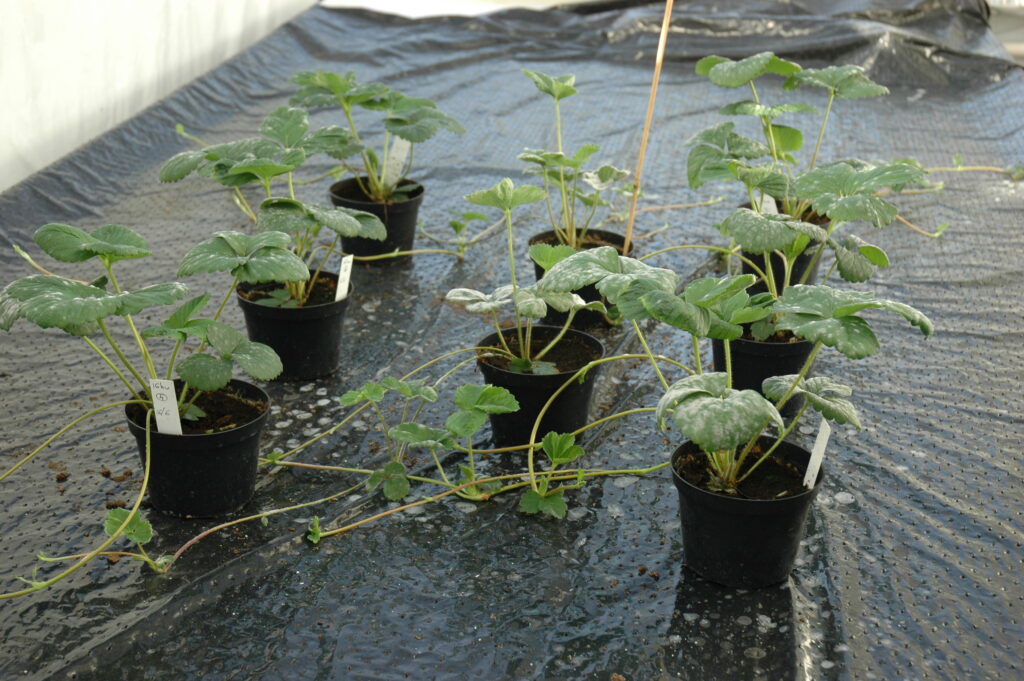
Credit A Stensvand
Chemical Pesticides in the Environment
Although chemical pesticides are often necessary to avoid high-yield losses, they can have negative environmental impacts; pesticides can leach into groundwater or run off into bodies of water, polluting drinking sources and harming aquatic ecosystems. Additionally, pesticides may harm non-target organisms, including beneficial insects, birds, mammals, and microorganisms, leading to a decrease in biodiversity, which in turn can disrupt ecosystems.
Some pesticides can also harm the health of the soil by reducing its fertility and killing beneficial microorganisms, ultimately leading to a decrease in soil productivity over time. What’s more, diseases and pests can develop resistance to chemical pesticides, thus reducing their efficacy and increasing crop losses.
It is important not to forget that the final destination of many crops is to be eaten by humans and animals; eating plants that have been treated with pesticides means the chemicals, in some cases, can linger throughout the food chain.
Thermotherapy with the Plant Sauna
Thermotherapy, also known as heat treatment, has emerged as an effective strategy for managing diseases and pests in a variety of crops, including strawberries. One method of thermotherapy is soil solarisation, which involves covering the soil with a clear plastic tarp during the hottest part of the year. The sun heats the soil beneath the tarp, killing many soil-borne diseases and pests. Another method is steam sterilisation, where steam is injected into the soil to kill pests. A third method involves heating the plants themselves, either by immersing them in hot water or by exposing them to hot steam.
Immersing plants in hot water has been a practice for decades with the aim of removing diseases and pests. One of the most successful warm water treatments has been against the strawberry mite (Phytonemus pallidus), also called cyclamen mite, which is a devastating pest if brought in with the planting material. However, the abrasiveness of full immersion in hot water may cause damage to the plants themselves and may be challenging if treating large quantities of plants. Dr Stensvand and his team in Norway, in close collaboration with colleagues at the University of Florida, have carried out extensive research into the use of steam as an alternative to hot water, with promising results.
Dr Stensvand’s team presents the results of aerated steam treatment on powdery mildew (Podosphaera aphanis) in a 2023 paper. Powdery mildew is caused by an ascomycetous fungus, and it is one of the most prevalent strawberry diseases. The team found that exposing the infected plants to 40°C for 2 hours eradicated all the powdery mildew that was present before. Moreover, none of the new leaves that sprouted after treatment had any powdery mildew present, whereas half of the new leaves on the untreated plants were infected.
This is a vastly important step in IPM research as this method can be scaled up for use in large-scale farming with the help of chambers known as plant saunas. These chambers monitor the temperature and adjust accordingly for the treatment of many transplants.
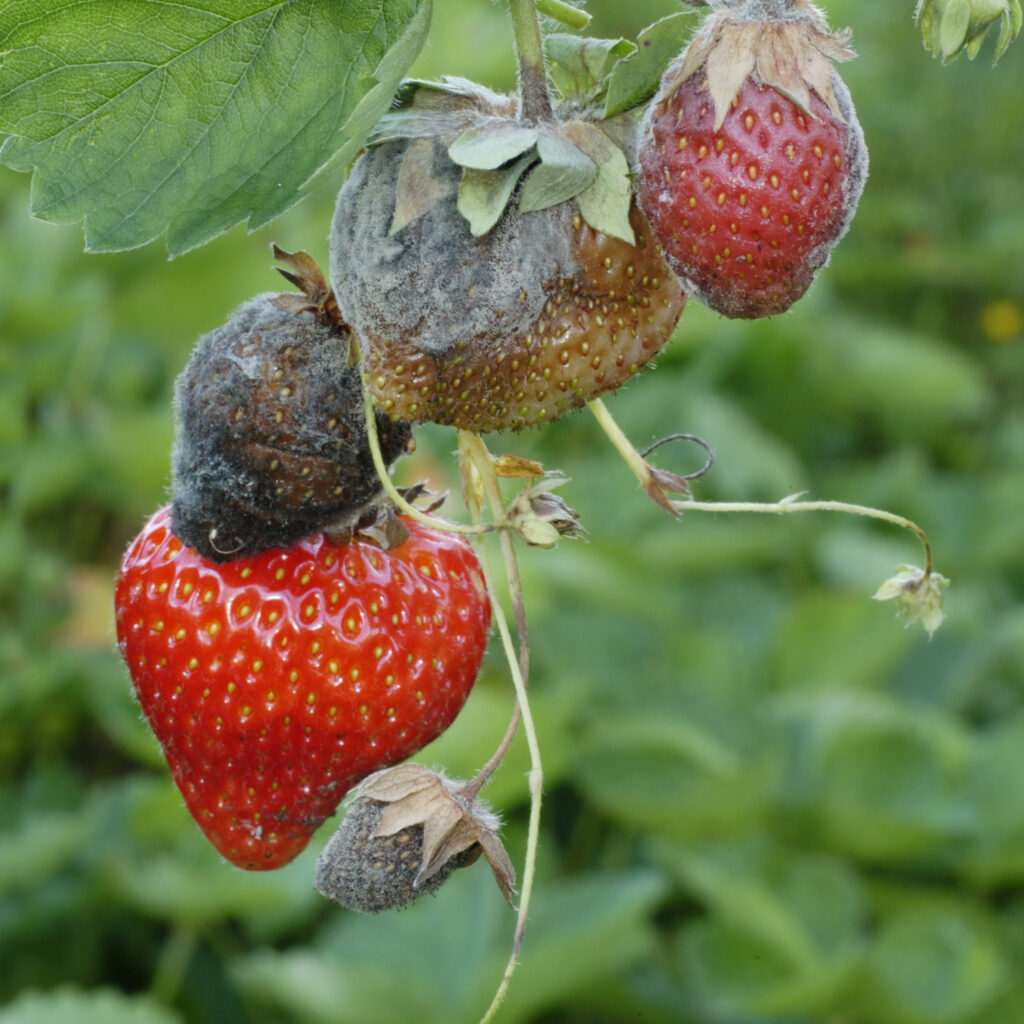
Credit E Fløistad
Treatment of Fungicide Resistant Grey Mould
One of the great challenges with treating diseases is antimicrobial resistance, whereby germs like bacteria and fungi develop resistance to the drugs designed to kill them. This is mostly seen with strains of microbes that have high frequency of mutations and multiply and spread rapidly, resulting in more chances for natural immunity. Therefore, infections caused by these resistant strains can be difficult, and sometimes impossible, to treat. Microbial resistance is most commonly associated with human infections such as methicillin-resistant Staphylococcus aureus (more commonly known as MRSA). However, plants can also be affected by strains of bacteria and fungi that do not respond to pesticides.
Grey mould, caused by several species of Botrytis, is one of the most prevalent fungal diseases in strawberries, and sometimes more than 70% of crops are lost when no fungicides are used. Therefore, not just flowering and fruiting strawberry plants but also transplants are commonly treated with chemical fungicides. However, Botrytis is a fast-mutating and also rapidly multiplying microbe, which has led researchers to be concerned about the rise in fungicide-resistant strains. Reducing populations of Botrytis in transplants before planting in fruit fields is therefore vital, both to reduce the disease pressure and to reduce fungicide-resistant strains.
Finding a non-chemical alternative to fungicides that will also reduce the population of fungicide-resistant microbes is critical to Dr Stensvand and his team. Their 2023 paper reports that steam thermotherapy treatment at 44°C strongly reduced Botrytis in plants. This included fungicide-resistant strains, which would have remained on the plants if treated with fungicides. Due to the nature of strawberry transplanting, the microbes would be passed onto future generations, both in the plant-producing facilities and in the fruit production.
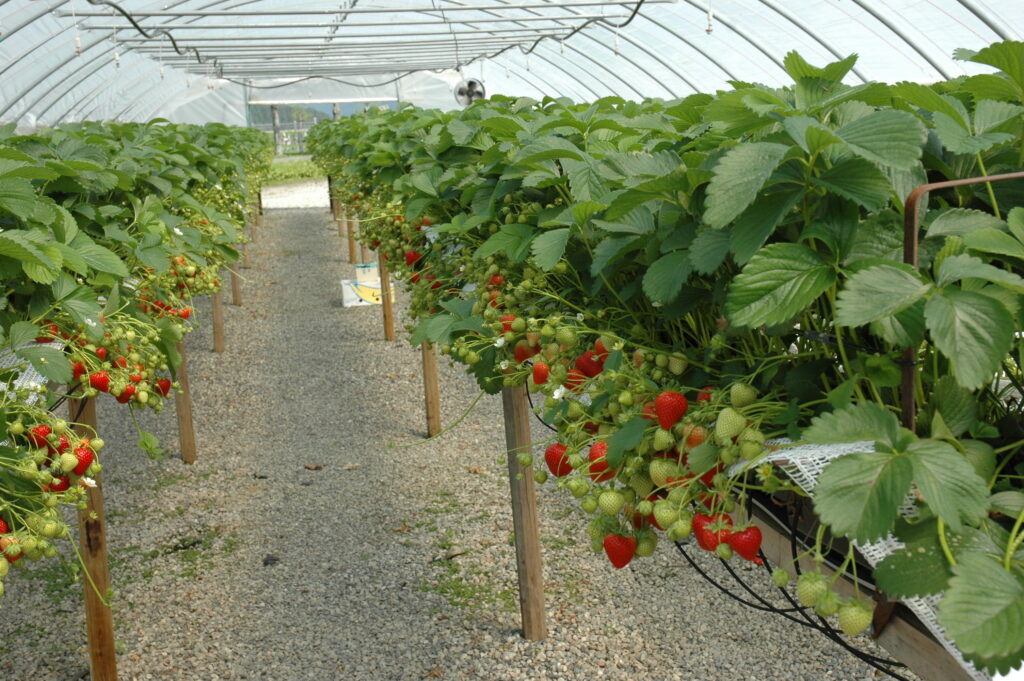
Credit A Stensvand
The Two-spotted Mite and the Strawberry Mite
There are two common mites that affect the strawberry plants – two-spotted spider mites (Tetranychus urticae) and strawberry mites. Further exciting results came in the 2022 paper showing that the strawberry mite was almost completely eradicated when exposed to warm steam at 44°C. However, the two-spotted spider mite hardly responded to the treatment and, therefore, requires other means of control.
Cold-stored plants in both Norway and Florida tolerated the treatments well; however, some plant qualities may be more sensitive to 44°C and the current exposure times up to 4 hours. Dr Stensvand points out that increasing the temperature above 44°C could seriously impact the plants and leave more crop devastation.
Continuing the Research
Continuing the work towards more sustainable disease and pest control methods is something Dr Stensvand and his team are at the forefront of, and they are currently expanding their work on thermotherapy to other crops. It is crucial to keep finding alternative methods to combine with pesticides when only absolutely necessary, and the work the team are doing is greatly contributing towards this movement. They are not only focused on thermotherapy but have some exciting developments in the use of UV light to reduce powdery mildew and two-spotted spider mites, which could be used alongside other techniques. Dr Stensvand is committed to IPM and making non-chemical interventions in pest control commonplace in crop production.
SHARE
DOWNLOAD E-BOOK
REFERENCE
https://doi.org/10.33548/SCIENTIA1035
MEET THE RESEARCHER

Dr Arne Stensvand
Department of Plant Sciences
Norwegian Institute of Bioeconomy Research (NIBIO)
Norway
Dr Arne Stensvand obtained his MSc at the Norwegian University of Life Sciences (NMBU) in 1989 and his PhD in plant pathology in 1994 at NMBU and the Norwegian Institute of Bioeconomy Research (NIBIO). After working as a research scientist at NIBIO from 1993 to 2002, Dr Stensvand was promoted to senior research scientist, a position he still holds today. Dr Stensvand has undertaken a number of roles throughout his career, including director of research at NIBIO (2003 to 2004) and a professorship in plant pathology at NMBU from 2008. Dr Stensvand has carried out extensive research into plant pathology, especially relating to berries and fruits. Obtaining non-chemical alternatives to pesticides for environmental and economic reasons has been a consistent theme in his dedicated career.
CONTACT
E: arne.stensvand@nibio.no
W: https://www.nibio.no/en/employees/arne-stensvand
KEY COLLABORATORS
Mr Vinh Hong Le, Norwegian Institute of Bioeconomy Research
Dr Nina Trandem, Norwegian Institute of Bioeconomy Research
Dr Nina S Johansen, Norwegian Institute of Bioeconomy Research
Dr Katherine AG Nielsen, Norwegian Institute of Bioeconomy Research
Dr Anita Sønsteby, Norwegian Institute of Bioeconomy Research
Dr Natalia A Peres, University of Florida, Gulf Coast Research and Extension Center, USA
Dr William W Turechek, U. S. Horticultural Research Laboratory, USDA-ARS, Fort Pierce, Florida, USA
Mr Ole Myhrene, Moleda AS, Norway
Mr Simen Myhrene, Moleda AS, Norway
FUNDING
The Foundation for Research Levy on Agricultural Products and Grofondet (grant no. 280608 of the Research Council of Norway)
The Norwegian Financial Mechanism for 2014-2021 (grant no. NOR/ POLNOR/ QualityBerry/ 0014/ 2019-00)
FURTHER READING
B Gahatraj, KAG Nielsen, VH Le, et al., Steam thermotherapy strongly reduces Botrytis in strawberry transplants with no or minor negative effects on plant growth and yield, European Journal of Plant Pathology, 2023, 166, 109–121. DOI: https://doi.org/10.1007/s10658-023-02644-9
A Stensvand, NY Wang, VH Le, et al., Aerated steam eradicates powdery mildew from strawberry transplants, European Journal of Plant Pathology, 2023. DOI: https://doi.org/10.1007/s10658-023-02744-6
NS Johansen, N Trandem, VH Le, A Stensvand, The potential for using aerated steam to eradicate strawberry mite and two-spotted spider mite on strawberry transplants, Experimental & Applied Acarology, 2022, 88(3–4), 243–262. DOI: https://doi.org/10.1007/s10493-022-00757-0

REPUBLISH OUR ARTICLES
We encourage all formats of sharing and republishing of our articles. Whether you want to host on your website, publication or blog, we welcome this. Find out more
Creative Commons Licence (CC BY 4.0)
This work is licensed under a Creative Commons Attribution 4.0 International License. 
What does this mean?
Share: You can copy and redistribute the material in any medium or format
Adapt: You can change, and build upon the material for any purpose, even commercially.
Credit: You must give appropriate credit, provide a link to the license, and indicate if changes were made.
SUBSCRIBE NOW
Follow Us
MORE ARTICLES YOU MAY LIKE
Dr L Donald Duke | Riding the Storm: How Nature-Based Solutions Can Help Tackle Flooding in Southwest Florida
Florida grapples with mounting challenges related to inland flooding due to heavy precipitation, along with coastal flooding from rising sea levels and coastal storms. One important approach to address precipitation-originating flooding is to embrace land use practices runoff management in the upstream portions of at-risk watersheds, where sustainable design can relieve the pressures on drainage systems from continuing dense urban development in the low-lying Florida landscape. Dr L Donald Duke, from The Water School at Florida Gulf Coast University, plays a pivotal role in this endeavour. His work encompasses creating and evaluating flood-resilient land use practices and planning to manage stormwater runoff on the watershed scale.
Improving Food Safety of Hydroponic Leafy Greens
Hydroponic farming is experiencing rapid growth worldwide, offering a sustainable and efficient method of producing fresh, nutrient-rich crops. However, the unique conditions of hydroponic systems also present complex food safety challenges. Dr Sanja Ilic and Dr Melanie Lewis Ivey, researchers at The Ohio State University, are at the forefront of efforts to understand and mitigate the risks of human pathogen contamination in commercial hydroponic production. Their pioneering work is providing crucial insights and practical guidance to help ensure the safety and nutritional value of hydroponically grown leafy greens.
Dr Yasjka Meijer | Monitoring Greenhouse Gas Emissions from Space: The Copernicus CO2M Mission
Atmospheric concentrations of carbon dioxide (CO2) and methane (CH4) have been steadily rising due to human activities, contributing to global climate change. Dr Yasjka Meijer from the European Space Agency is responsible for the objectives and requirements of the Copernicus Anthropogenic Carbon Dioxide Monitoring (CO2M) mission – a constellation of satellites that will enable the monitoring of anthropogenic greenhouse gas emissions from space with unprecedented accuracy and detail. This groundbreaking mission aims to support international efforts to reduce emissions and combat climate change.
Renewable Fuel for a Generation of Green Batteries
Revolutionizing energy production has been integral to combatting climate change and reducing our dependence on limited natural resources, but complementary advances in energy storage have been lacking. Dr Thomas Guarr and Dr David Hickey from Michigan State University lead their team in investigating a counterintuitive molecular mechanism which could support a wave of green, renewable, and cheap batteries. If practical, this technology might be the crucial leap towards an entirely green energy system.


